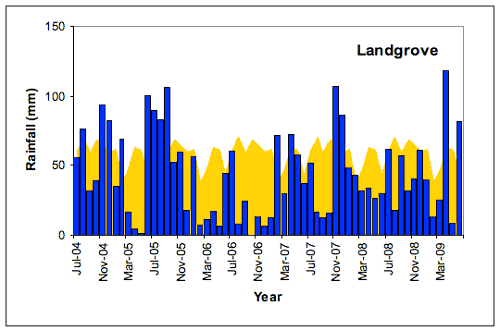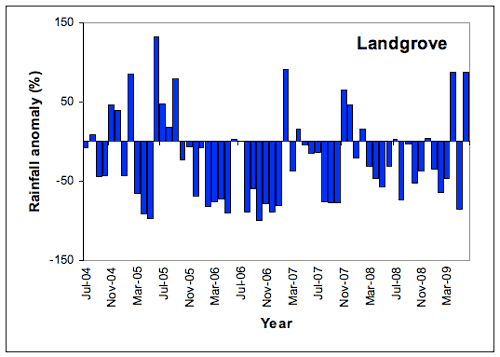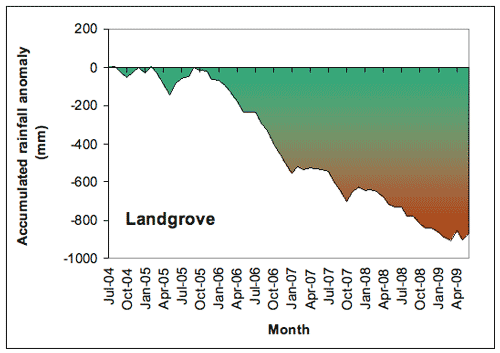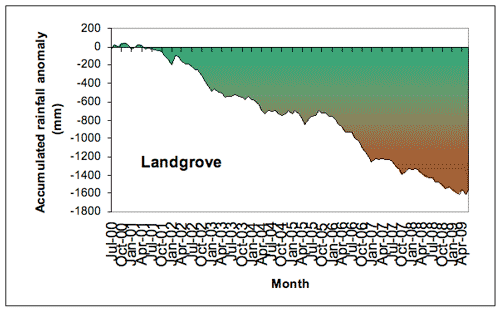Cootamundra
Please note: Text or data highlighted in this colour represent an update to this indicator for the period 2008/09. All rainfall figures have been updated on this page.
Rainfall Analysis
The main rainfall observing site used in this analysis was Landgrove (Bureau of Meteorology Station No. 073022), which has records commencing in 1891. Landgrove is 6.2 km from the centre of Cootamundra. Data from nearby stations were used to calculate values for months with missing data at this site, and to extend the record back to 1889 (see Appendix 2 for further information).
Note that in the following analyses rainfall totals for individual months or years (where the year is defined as the 12 months from July to June) are compared to the long-term average (or climatology) from 1961-1990. A 30-year period is used to calculate climatological averages to conform with World Meteorological Organisation practice; this takes into account year-to-year variations and less frequent events such as El Niño or La Niña. This particular 30-year period is used internationally as a standard climatological average period.
As shown in the table below, Landgrove was drier than average in all five years in the period 2004/05-2008/09. The driest year was 2006/07, when rainfall was 43.3% below the long-term average at 394 mm for the year. This was the fourth driest Jul-Jun 12 month period since 1891 and most likely 1889. The wettest year in the last four years was 2004/05, although rainfall was still 12.5% below average.
| Rainfall Statistics | Cootamundra (Landgrove) | ||||
|---|---|---|---|---|---|
2004/5 |
2005/6 |
2006/7 |
2007/8 |
2008/9 |
|
| Annual Total* (mm) | 607.9 |
552.2 |
394.0 |
504.5 |
559.0 |
| Anomaly (mm) | -86.9 |
-142.6 |
-300.8 |
-190.3 |
-135.8 |
| Anomaly (%) | -12.5 |
-20.5 |
-43.3 |
-27.4 |
-19.5 |
| Mean (1961-1990) (mm) | 694.8 |
||||
*Note: annual totals were calculated for the 12 months July-June.
Monthly Rainfall, 2004-2009
A comparison of monthly rainfall totals with the long-term monthly average rainfall at Landgrove (Figure 1) shows that most of the period experienced below-average rainfall, interspersed with small periods of above average rainfall. There was a prolonged period of below-average rainfall between October 2005 and January 2007. During this period there were only two years of average rainfall and three years of just below average rainfall. For the period July 2008 to June 2009, there were also another 8 months of below average rainfall. For the remainder of this period rainfall was very much below average reflecting the El Niño event of 2006/7. Rainfall for the period November 2005 to February 2006 was generally above average while the periods June to September 2005 and November to December 2007 were well above average. Dry conditions returned for the March 2008 to March 2009 period. The rainfall in late 2007 was related to a La Niña event, while there was little or no impact on rainfall in late 2008 from another La Niña event.
 |
Of the 60 months in this period, 42 months (70% of the record) had below-average rainfall at Landgrove (Figure 2) with 11 out of 16 months between October 2005 and January 2007 being exceptionally dry. Other periods of very dry conditions were autumn of 2005 and March 2008 to April 2009. The driest month was October 2006 (long term average for October is 68,6 mm) while May 2005 only recorded 1.6 mm. Conditions were significantly wetter than normal during November and December 2005, June to September 2005, November and December 2007 and April and June 2009. The wettest month was April 2009 when 118.9 mm (long term average for November is 63.0 mm). This was the eighth highest total for April on record since 1891 and possibly since 1889. The three other months where 100 mm or more were recorded were November 2007 (106.8 mm) September 2005 (106 mm) and June 2005 (100 mm).
 |
The result of the generally dry conditions at Landgrove can be seen in Figure 3. Rainfall accumulation remained close to the norm from July 2004 to October 2005 from which time the rainfall deficit increased rapidly to January 2007 and continued to increase more slowly through to June 2008, with the deficit further increasing during 2008. The continued increase in the deficit through this period is a reflection of the continued dry conditions persisting from the El Niño event of 2006/7. The total accumulated deficit for this five year period is 867.8 mm (125% of the Jul-Jun average).
 |
The climatological context for rainfall at Landgrove
The long-term perspective
As is typical of the region, Landgrove has experienced large fluctuations in annual (July-June) rainfall, including several extended periods of above- or below-average rainfall since records began in 1891. In general, annual rainfall was lower and less variable early in the 20th century, followed by a period of greater variability. Rainfall variability has been lower since about 1980 (Figure 4). The recent dry period is reflected in other parts of the long term record such as the period during the late 19th and early part of the 20th Century and the period from the late 1920’s through to the end of World War 2. To this point in time this recent dry period can only be considered as part of the long term variability in rainfall experienced in the region.
- Rainfall in the late 19th and early 20th century was generally below average (to about 1920), with the notable exception of a short wet period in the 1930s. Since then annual rainfall totals have been more variable.
- Several wetter-than-normal years around 1960 and in the mid 1970s produced generally wetter periods then.
- A drier period around 1980 was followed by some good rainfall years until the early 1990s. Since 1993 conditions have been generally drier than average.
The wettest year (July-June) on record was 1930/31 (1148 mm); the driest year was 1928/29 (340 mm).
![Figure 5. Accumulated Landgrove monthly rainfall totals (in mm), expressed as anomalies (differences between the actual amount of rainfall that accumulated from month to month during the period July 2000-June 2008, and the amount that would have accumulated if average rainfall had been received each month).4. Annual (July-June) rainfall at Landgrove from 1889/90 to 2008/9 depicted as deviations from the long-term mean. A 5-year running mean is superimposed to highlight wetter and drier periods. [Deviations were calculated as the difference between the rainfall for each year and the mean for the period 1961-1990 (scale in mm).]](../images/cootamundra/rain04.gif) |
Figure 5 indicates that the dry period during 2004 to 2009 was a continuation of the dry period that commenced in 2002 and reflects the impacts of the two El Niño years of 2002-3 and 2006-7 without a compensating wet period. During this whole period there were 76 months (70%) of rainfall deficit and the total accumulated deficit was 1561.8 mm (225 % of the average Jul-Jun rainfall).
 |
About the data
